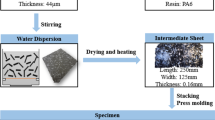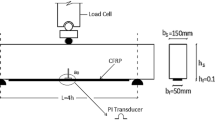Abstract
This paper aims to experimentally and numerically explore fracture mechanism characteristics of ultra-thin chopped carbon fiber tape-reinforced thermoplastics (UT-CTT) hat-shaped hollow beam under transverse static and impact loadings. Three distinct failure modes were observed in the impact bending tests, whereas only one similar progressive collapse mode was observed in the transverse bending tests. The numerical model was to incorporate some hypothetical inter-layers in UT-CTT and assign them with the failure model as cohesive zone model, which can perform non-linear characteristics with failure criterion for representing delamination failure. The dynamic material parameters for the impact model were theoretically predicted with consideration of strain-rate dependency. It shows that the proposed modeling approach for interacting damage modes can serve as a benchmark for modeling damage coupling in composite materials.














Similar content being viewed by others
References
Liu Q, Xing HL, Ju Y, Ou ZY, Li Q (2014) Quasi-static axial crushing and transverse bending of double hat shaped CFRP tubes. Compos Struct 117:1–11
Koricho EG, Belingardi G (2015) An experimental and finite element study of the transverse bending behaviour of CFRP composite T-joints in vehicle structures. Compos B Eng 79:430–443
Kim J-H, Nguyen K-H, Choi J-H, Kweon J-H (2016) Experimental and finite element analysis of curved composite structures with C-section. Compos Struct 140:106–117
Atthapreyangkul A, Prusty BG (2017) Experimental and numerical analysis on the geometrical parameters towards the maximum SEA of CFRP components. Compos Struct 164:229–236
Liu Q, Ou Z, Mo Z, Li Q, Qu D (2015) Experimental investigation into dynamic axial impact responses of double hat shaped CFRP tubes. Compos B Eng 79:494–504
Wang Y, Feng J, Wu J, Hu D (2016) Effects of fiber orientation and wall thickness on energy absorption characteristics of carbon-reinforced composite tubes under different loading conditions. Compos Struct 153:356–368
Subbaramaiah R, Prusty BG, Pearce GMK, Lim SH, Thomson RS (2017) Crashworthy response of fibre metal laminate top hat structures. Compos Struct 160:773–781
Kabir MH, Fawzia S, Chan THT, Gamage JCPH, Bai JB (2016) Experimental and numerical investigation of the behaviour of CFRP strengthened CHS beams subjected to bending. Eng Struct 113:160–173
Alam MI, Fawzia S, Zhao XL (2016) Numerical investigation of CFRP strengthened full scale CFST columns subjected to vehicular impact. Eng Struct 126:292–310
Chen Y, Feng R, He K, Chen X, Huang J (2018) Flexural behaviour of concrete-filled stainless steel SHS and RHS tubes strengthened by CFRP. Thin-Walled Struct 122:208–229
Shin DK, Kim HC, Lee JJ (2014) Numerical analysis of the damage behavior of an aluminum/CFRP hybrid beam under three point bending. Compos B Eng 56:397–407
Yamashita M, Yamamoto I (2016) Bending collapse behaviour of hat-shaped tubular structure strengthened with CFRP sheet. Adv Mater Process Technol 2(4):461–470
Kim SY, Jeong JW, Kim JY, Kim HC, Shin DK, Shin KC, Lee JJ (2016) Energy absorption characteristics of aluminium/CFRP hybrid beam under impact loading. Int J Crashworthiness 22(2):190–201
Kim HC, Shin DK, Lee JJ (2013) Characteristics of aluminum/CFRP short square hollow section beam under transverse quasi-static loading. Compos B Eng 51:345–358
Selezneva M, Roy S, Lessard L, Yousefpour A (2016) Analytical model for prediction of strength and fracture paths characteristic to randomly oriented strand (ROS) composites. Compos B Eng 96:103–111
Selezneva M, Lessard L (2015) Characterization of mechanical properties of randomly oriented strand thermoplastic composites. J Compos Mater 50(20):2833–2851
Feraboli P, Peitso E, Deleo F, Cleveland T, Stickler PB (2009) Characterization of prepreg-based discontinuous carbon fiber/epoxy systems. J Reinf Plast Compos 28(10):1191–1214
Feraboli P, Peitso E, Cleveland T, Stickler PB (2009) Modulus measurement for prepreg-based discontinuous carbon fiber/epoxy systems. J Compos Mater 43(19):1947–1965
Visweswaraiah SB, Selezneva M, Lessard L, Hubert P (2018) Mechanical characterisation and modelling of randomly oriented strand architecture and their hybrids—a general review. J Reinf Plast Compos 37(8):548–580
Yamashita S, Hashimoto K, Suganuma H, Takahashi J (2016) Experimental characterization of the tensile failure mode of ultra-thin chopped carbon fiber tape-reinforced thermoplastics. J Reinf Plast Compos 35(18):1342–1352
Guo Q, Ohsawa I, Takahashi J (2019) L-shaped structures made from ultrathin chopped carbon fiber tape reinforced thermoplastics: delamination behavior and optimization. Adv Compos Mater 28:1–11
Wan Y, Matsuo T, Ohsawa I, Takahashi J (2014) Effects of curvature on strength and damage modes of L-shaped carbon fiber-reinforced polypropylene. J Reinf Plast Compos 33(14):1305–1315
Matsuo T, Kan M, Furukawa K, Sumiyama T, Enomoto H, Sakaguchi K (2017) Numerical modeling and analysis for axial compressive crushing of randomly oriented thermoplastic composite tubes based on the out-of-plane damage mechanism. Compos Struct 181:368–378
Topac OT, Gozluklu B, Gurses E, Coker D (2017) Experimental and computational study of the damage process in CFRP composite beams under low-velocity impact. Compos A Appl Sci Manuf 92:167–182
Zhang J, Zhang X (2015) Simulating low-velocity impact induced delamination in composites by a quasi-static load model with surface-based cohesive contact. Compos Struct 125:51–57
Panettieri E, Fanteria D, Danzi F (2016) A sensitivity study on cohesive elements parameters: towards their effective use to predict delaminations in low-velocity impacts on composites. Compos Struct 137:130–139
Ullah H, Harland AR, Silberschmidt VV (2013) Damage and fracture in carbon fabric reinforced composites under impact bending. Compos Struct 101:144–156
Waimer M, Siemann MH, Feser T (2017) Simulation of CFRP components subjected to dynamic crash loads. Int J Impact Eng 101:115–131
Lyu X (2016) Dynamic and viscoelastic behavior of discontinuous carbon fiber reinforced thermoplastics. The University of Tokyo, Tokyo
Dow NF, Gruntfest IJ (1960) Determination of most needed potentially possible improvements in materials for ballistic and space vehicles. Gen Electr Co Air Force Contract AF 4(647):269
Acknowledgements
Part of this study was conducted as Japanese METI project “The Future Pioneering Projects/Innovative Structural Materials Project” since 2013fy. Authors would like to express sincere appreciation to the project members who have provided valuable information and useful discussions.
Author information
Authors and Affiliations
Corresponding author
Ethics declarations
Conflict of interest
On behalf of all authors, the corresponding author states that there is no conflict of interest.
Additional information
Publisher's Note
Springer Nature remains neutral with regard to jurisdictional claims in published maps and institutional affiliations.
Rights and permissions
About this article
Cite this article
Guo, Q., Xiao, B., Ohsawa, I. et al. Fracture mechanism characteristics of ultra-thin chopped carbon fiber tape-reinforced thermoplastics hat-shaped hollow beam under transverse static and impact loadings. Carbon Lett. 30, 271–280 (2020). https://doi.org/10.1007/s42823-019-00095-z
Received:
Revised:
Accepted:
Published:
Issue Date:
DOI: https://doi.org/10.1007/s42823-019-00095-z




